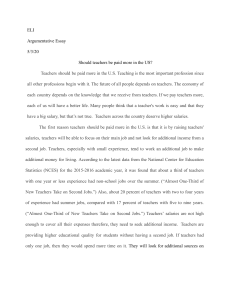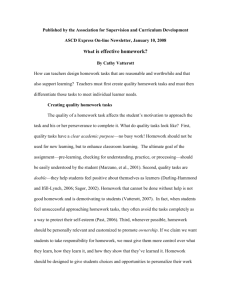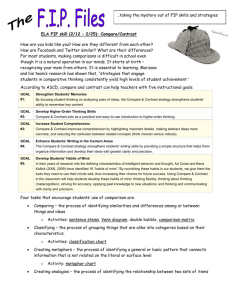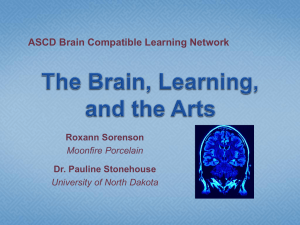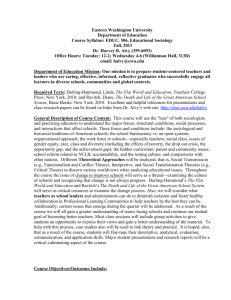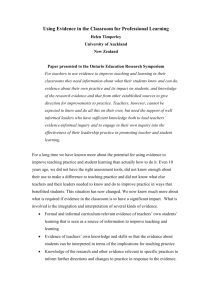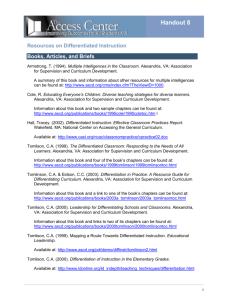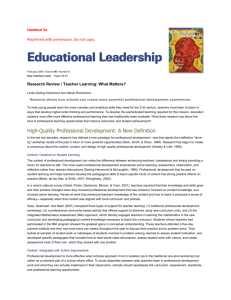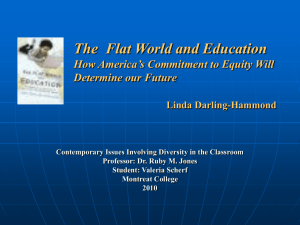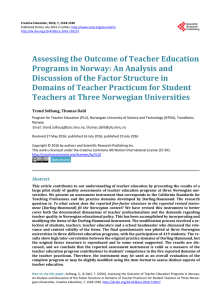What Teachers Need to Know
advertisement
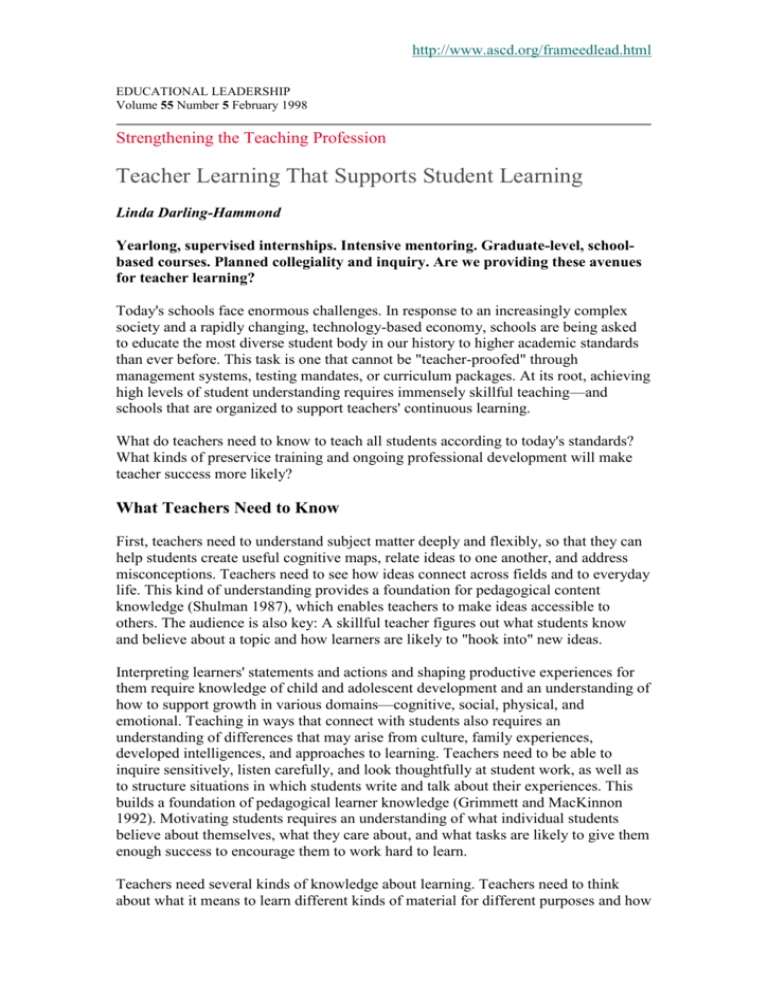
http://www.ascd.org/frameedlead.html EDUCATIONAL LEADERSHIP Volume 55 Number 5 February 1998 Strengthening the Teaching Profession Teacher Learning That Supports Student Learning Linda Darling-Hammond Yearlong, supervised internships. Intensive mentoring. Graduate-level, schoolbased courses. Planned collegiality and inquiry. Are we providing these avenues for teacher learning? Today's schools face enormous challenges. In response to an increasingly complex society and a rapidly changing, technology-based economy, schools are being asked to educate the most diverse student body in our history to higher academic standards than ever before. This task is one that cannot be "teacher-proofed" through management systems, testing mandates, or curriculum packages. At its root, achieving high levels of student understanding requires immensely skillful teaching—and schools that are organized to support teachers' continuous learning. What do teachers need to know to teach all students according to today's standards? What kinds of preservice training and ongoing professional development will make teacher success more likely? What Teachers Need to Know First, teachers need to understand subject matter deeply and flexibly, so that they can help students create useful cognitive maps, relate ideas to one another, and address misconceptions. Teachers need to see how ideas connect across fields and to everyday life. This kind of understanding provides a foundation for pedagogical content knowledge (Shulman 1987), which enables teachers to make ideas accessible to others. The audience is also key: A skillful teacher figures out what students know and believe about a topic and how learners are likely to "hook into" new ideas. Interpreting learners' statements and actions and shaping productive experiences for them require knowledge of child and adolescent development and an understanding of how to support growth in various domains—cognitive, social, physical, and emotional. Teaching in ways that connect with students also requires an understanding of differences that may arise from culture, family experiences, developed intelligences, and approaches to learning. Teachers need to be able to inquire sensitively, listen carefully, and look thoughtfully at student work, as well as to structure situations in which students write and talk about their experiences. This builds a foundation of pedagogical learner knowledge (Grimmett and MacKinnon 1992). Motivating students requires an understanding of what individual students believe about themselves, what they care about, and what tasks are likely to give them enough success to encourage them to work hard to learn. Teachers need several kinds of knowledge about learning. Teachers need to think about what it means to learn different kinds of material for different purposes and how http://www.ascd.org/frameedlead.html to decide which kinds of learning are most necessary in different contexts. Teachers must be able to use different teaching strategies to accomplish various goals and many means for evaluating students' knowledge and assessing students' approaches to learning. Teachers must be able to identify the strengths of different learners while addressing their weaknesses. In addition, all teachers need tools to work with students who have specific learning disabilities or needs. And because language is the gateway to learning, teachers must understand how students acquire language, so that they can build language skills and create accessible learning experiences. Teachers need to know about curriculum resources and technologies to connect their students with sources of information and knowledge that allow them to explore ideas, acquire and synthesize information, and frame and solve problems. And teachers need to know about collaboration—how to structure interactions among students so that more powerful shared learning can occur; how to collaborate with other teachers; and how to work with parents to learn more about their children and to shape supportive experiences at school and home. Finally, teachers need to be able to analyze and reflect on their practice, to assess the effects of their teaching, and to refine and improve their instruction. They must continously evaluate what students are thinking and understanding and reshape their plans to take account of what they've discovered. New Strategies for Teacher Learning Acquiring this sophisticated knowledge and developing a practice that is different from what teachers themselves experienced as students requires learning opportunities for teachers that are more powerful than simply reading and talking about new pedagogical ideas (Ball and Cohen, in press). Teachers learn best by studying, doing, and reflecting; by collaborating with other teachers; by looking closely at students and their work; and by sharing what they see. This kind of learning cannot occur in college classrooms divorced from practice or in school classrooms divorced from knowledge about how to interpret practice. Good settings for teacher learning—in both colleges of education and schools—provide lots of opportunities for research and inquiry, for trying and testing, for talking about and evaluating the results of learning and teaching. The "rub between theory and practice" (Miller and Silvernail 1994) occurs most productively when questions arise in the context of real students and work in progress, and where research and disciplined inquiry are also at hand. Better settings for such learning are appearing. More than 300 schools of education in the United States have created programs that extend beyond the traditional four-year bachelor's degree program, providing both education and subject-matter coursework that is integrated with clinical training in schools. Some are one- or two-year graduate programs for recent graduates or midcareer recruits. Others are five-year models for prospective teachers who enter teacher education as undergraduates. In either case, the fifth year allows students to focus exclusively on the task of preparing to teach, with yearlong, school-based internships linked to coursework on learning and teaching. Studies have found that graduates of these extended programs are more satisfied with their preparation, and their colleagues, principals, and cooperating http://www.ascd.org/frameedlead.html teachers view them as better prepared. Extended program graduates are as effective with students as are much more experienced teachers and are much more likely to enter and stay in teaching than their peers prepared in traditional four-year programs (Andrew and Schwab 1995, Denton and Peters 1988, Shin 1994). Many of these programs have joined with local school districts to create Professional Development Schools. Like teaching hospitals, these schools aim to provide sites for state-of-the-art practice that are organized to support the training of new professionals, extend the professional development of veteran teachers, and sponsor collaborative research and inquiry. Both university and school faculty plan and teach in these programs. Beginning teachers get a more coherent learning experience when they are organized in teams with these faculty and with one another. Senior teachers deepen their knowledge by serving as mentors, adjunct faculty, co-researchers, and teacher leaders. Thus, these schools can help create the rub between theory and practice, while creating more professional roles for teachers and constructing knowledge that is more useful for both practice and ongoing theory building (DarlingHammond 1994). These new programs typically engage prospective teachers in studying research and conducting their own inquiries through cases, action research, and structured reflections about practice. They envision the professional teacher as one who learns from teaching rather than as one who has finished learning how to teach, and the job of teacher education as developing the capacity to inquire systematically and sensitively into the nature of learning and the effects of teaching. This is like the approach to knowledge production John Dewey (1929) sought—one that empowers teachers with greater understanding of complex situations rather than seeking to control them with simplistic formulas or cookie-cutter routines. If teachers investigate the effects of their teaching on students' learning, and if they read about what others have learned, they become sensitive to variation and more aware of what works for what purposes in what situations. Training in inquiry also helps teachers learn how to look at the world from multiple perspectives and to use this knowledge to reach diverse learners. As Lisa Delpit (1995) notes, We all interpret behaviors, information, and situations through our own cultural lenses; these lenses operate involuntarily, below the level of conscious awareness, making it seem that our own view is simply "the way it is" (p. 151). Teachers concerned with democratic education must develop an awareness of their perspectives and how these can be enlarged to avoid a "communicentric bias" (Gordon et al. 1990) that limits understanding of students as well as of different areas of study. These goals suggest a new relationship between research and practice. For most of this century, policymakers sought knowledge to aid in the remote control of teaching—generalizable dictums that could shape teaching via texts, curriculum packages, and teacher manuals. When these proved inadequate, teachers were left with the knowledge they'd managed to accumulate on their own. By contrast, the kind of learning found in rich professional development settings has several key features (Ball and Cohen, in press): http://www.ascd.org/frameedlead.html It is centered around the critical activities of teaching and learning— planning lessons, evaluating student work, developing curriculum— rather than in abstractions and generalities; It grows from investigations of practice through cases, questions, analysis, and criticism; and It is built on substantial professional discourse that fosters analysis and communication about practices and values in ways that build colleagueship and standards of practice. These elements need to be part of a seamless process of professional learning that begins in preservice education, continues through the early years of induction, and extends through years of developing accomplished practice. This approach is common elsewhere around the world and in a growing number of schools in the United States. Professional Learning in Practice Countries like Germany, Belgium, and Luxembourg have long required two to three years of graduate-level study for prospective teachers on top of an undergraduate degree in the subject(s) to be taught. Education courses include the study of child development and learning, pedagogy, and teaching methods, plus an intensively supervised internship in a school affiliated with the university. In 1989 both France and Japan undertook major teacher education reforms to extend both university- and school-based training. In France, all candidates now complete a graduate program in newly created University Institutes for the Preparation of Teachers that are connected to nearby schools. In Japan and Chinese Taipei, new teachers complete a year-long supervised internship with a reduced teaching load that allows for mentoring and additional study. By Japanese law, first-year teachers receive at least 20 days of inservice training and 60 days of professional development. Master teachers are released from their classrooms to advise and counsel them. In both Japan and China, new teachers watch other teachers at length, discuss problems of practice, present and critique demonstration lessons, and, with groups of colleagues, imagine and act out how students might respond to certain presentations of material. In their study of mathematics teaching in Japan, Taiwan, and the United States, Stigler and Stevenson (1991) note: [One of the] reasons Asian class lessons are so well crafted is that there is a very systematic effort to pass on the accumulated wisdom of teaching practice to each new generation of teachers and to keep perfecting that practice by providing teachers the opportunities to continually learn from each other (p. 46). Because schools in other countries provide for this kind of regular collegial exchange, teachers share knowledge and refine their practice throughout their careers. Without these supports, learning to teach well is extremely difficult. Most U.S. teachers start their careers in disadvantaged schools where turnover is highest, are assigned the most educationally needy students whom no one else wants to teach, are given the most demanding teaching loads with the greatest number of extra duties, and receive few curriculum materials and no mentoring. After this hazing, many leave. Others learn merely to cope rather than to teach well. After entry, teachers are expected to know everything they will need for a career, or to learn through workshops mostly on their own, with few structured opportunities to observe and http://www.ascd.org/frameedlead.html analyze teaching with others. As one high school teacher who had spent 25 years in the classroom once told me: "I have taught 20,000 classes; I have been 'evaluated' 30 times; but I have never seen another teacher teach." With this degree of isolation common, is it any wonder that shared knowledge and standards of practice are so difficult to forge? Some school districts have begun to create new models of induction and ongoing professional development for teachers and principals. These feature mentoring for beginners and veterans; peer observation and coaching; local study groups and networks for specific subject matter areas; teacher academies that provide ongoing seminars and courses of study tied to practice; and school-university partnerships that sponsor collaborative research, interschool visitations, and learning opportunities developed in response to teachers' and principals' felt needs. For example, at Wells Junior High, a Professional Development School working with the University of Southern Maine, The whole notion of staff development was turned on its head. The emphasis shifted from outside consultants to in-house experts. Collaborative learning groups replaced the traditional lecture/demonstration format. Problem posing and problem solving supplanted the recipes and prescriptions for effective schools that teachers had heard for years and never managed to implement. "Using the knowledge" became the starting point for developing a new view of staff development. . . . [Allocated workshop days] were used for teachers' review of research and for critical discussion and reflection. On one such day teachers spent two hours individually reading research about grouping. During another day, they worked in cooperative groups to share their perceptions on the research they had read. On yet another day, the staff met to engage in the process of consensus building with the goal of reaching a decision about grouping practices in the school (Miller and Silvernail 1994, pp. 30, 31). Similarly, at Fairdale High School in Louisville, Kentucky, teachers' research coupled with shared decision making produced major changes: As part of a self-study, 10 teachers followed 10 children through a school day. When it was over, teachers said things like, "It was boring," or, "You know, this isn't a very humane place to be." Teachers read and began to trade articles from the Kappan, Educational Leadership, and Education Week. . . . Even before participative management was initiated at Fairdale, the teachers started changing things. . . . "Make no mistake about it," [the principal] said, "We are building a professional culture." (Kerchner 1993, p. 9). In other schools, teachers have organized their learning around the development of standards and assessments of student work, evaluating both student learning and the effectiveness of their own teaching in the process. The result is a greater appreciation for what matters and what works, as well as what needs to change to promote student success. Professional development strategies that succeed in improving teaching share several features (Darling-Hammond and McLaughlin 1995). They tend to be: experiential, engaging teachers in concrete tasks of teaching, assessment, and observation that illuminate the processes of learning and development; grounded in participants' questions, inquiry, and experimentation as well as professionwide research; http://www.ascd.org/frameedlead.html collaborative, involving a sharing of knowledge among educators; connected to and derived from teachers' work with their students as well as to examinations of subject matter and teaching methods; sustained and intensive, supported by modeling, coaching, and problem solving around specific problems of practice; and connected to other aspects of school change. These approaches shift from old models of "teacher training" or "inservicing" to a model in which teachers confront research and theory directly, are regularly engaged in evaluating their practice, and use their colleagues for mutual assistance. The Benefit for Students Growing evidence suggests that this kind of professional development not only makes teachers feel better about their practice, but it also reaps learning gains for students, especially in the kinds of more challenging learning that new standards demand (Darling-Hammond 1997, NFIE 1996). Creating a profession of teaching in which teachers have the opportunity for continual learning is the likeliest way to inspire greater achievement for children, especially those for whom education is the only pathway to survival and success. References Andrew, M. D., and R. L. Schwab. (Fall 1995). "Has Reform in Teacher Education Influenced Teacher Performance? An Outcome Assessment of Graduates of Eleven Teacher Education Programs." Action in Teacher Education 17, 3: 43-53. Ball, D., and D. Cohen. (in press). "Developing Practice, Developing Practitioners: Toward a Practice-based Theory of Professional Education." In The Heart of the Matter: Teaching as the Learning Profession, edited by L. Darling-Hammond and L. Sykes. San Francisco: Jossey-Bass. Darling-Hammond, L. (1997). Doing What Matters Most: Investing in Quality Teaching. New York: The National Commission on Teaching and America's Future. Darling-Hammond, L., and M. W. McLaughlin. (1995). "Policies That Support Professional Development in an Era of Reform." Phi Delta Kappan 76, 8: 597-604. Darling-Hammond, L., ed. (1994). Professional Development Schools: Schools for Developing a Profession. New York: Teachers College Press. Delpit, L. (1995). Other People's Children: Cultural Conflict in the Classroom. New York: New Press. Denton, J. J., and W. H. Peters. (1988). "Program Assessment Report: Curriculum Evaluation of a Non-traditional Program for Certifying Teachers." Unpublished report. College Station: Texas A&M University. http://www.ascd.org/frameedlead.html Dewey, J. (1929). The Sources of a Science of Education. New York: Horace Liveright. Gordon, E. W., F. Miller, and D. Rollock. (1990). "Coping with Communicentric Bias in Knowledge Production in the Social Sciences." Educational Researcher 19: 14-19. Grimmett, P., and A. MacKinnon. (1992). "Craft Knowledge and the Education of Teachers." In Review of Research in Education 18, edited by G. Grant. Washington, D.C.: American Educational Research Association. Kerchner, C. T. (1993). "Building the Airplaine as It Rolls Down the Runway." School Administrator 50, 10: 8-15. Miller, L., and D. L. Silvernail. (1994). "Wells Junior High School: Evolution of a Professional Development School." In Professional Development Schools: Schools for Developing a Profession, edited by L. Darling-Hammond. New York: Teachers College Press. National Foundation for the Improvement of Education. (1996). Teachers Take Charge of Their Learning: Transforming Professional Development for Student Success. Washington, D.C.: Author. Shin, H. (1994). "Estimating Future Teacher Supply: An Application of Survival Analysis." Paper presented at the annual meeting of the American Educational Research Association, New Orleans. Shulman, L. (1987). "Knowledge and Teaching: Foundations of the New Reform." Harvard Educational Review 57, 1: 1-22. Stigler, J. W., and H. W. Stevenson. (Spring 1991). "How Asian Teachers Polish Each Lesson to Perfection." American Educator 15, 1: 12-21, 43-47. Author's note: This article draws in substantial part on the author's recently published book, The Right to Learn (San Francisco: Jossey-Bass, 1997). Editor's note: See p. 90 for a review of The Right to Learn. Linda Darling-Hammond is William F. Russell Professor at Teachers College, Columbia University, New York, and Executive Director of the National Commission on Teaching and America's Future. Address correspondence to the author at Teachers College, 525 W. 120th St., New York, NY 10027 (e-mail: ld70@columbia.edu).
